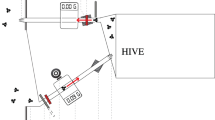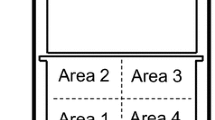Abstract
Upon leaving the hive, foragers carry a small amount of honey, which they subsequently consume to generate energy for flight. We investigated the relationship between waggle-phase duration and crop volume in foragers (both dancers and dance followers) leaving the hive. Our findings indicate that these variables were positively correlated in the two types of bee, suggesting that they were able to adjust the amount of food that they carry depending on the distance to a food source. We also found that dance followers left the hive with a larger amount of honey than dancers. We suggest two possible explanations: (1) dance followers have less information about the location of the food source than dancers, who have a better knowledge of the surrounding area; or (2) honeybees lack a precise calibration method for estimating energy needs from waggle-run duration. The effect of foraging experience was confirmed: bees decreased their honey load at departure with repeated trips to a sugar-syrup feeder. Honeybees showed a different pattern of change when the feeder provided soybean flour as a pollen substitute, possibly because honeybees use honey not only as an energy source but also as “glue” to form “balls” of pollen on their hind legs. Based on our observations that followers of sugar-syrup foragers carry a different amount of honey in their crop than followers of soybean-followers, we suggest that waggle dancers also convey information concerning food type.






Similar content being viewed by others
References
Balderrama NM, de Almeida LOB, Núñez JA (1992) Metabolic rate during foraging in the honeybee. J Comp Physiol B 162:440–447
Beutler R (1950) Zeit und Raum im Leben der Sammelbiene. Naturwissenschaften 37:102–105
Beutler R (1951) Time and distance in the life of the foraging bee. Bee World 32:25–27
Biesmeijer JC, Seeley TD (2005) The use of waggle dance information by honey bees throughout their foraging careers. Behav Ecol Sociobiol 59:133–142
Brandstetter M, Crailsheim K, Heran H (1988) Provisioning of food in the honeybee before foraging. BIONA Rep 6:129–148
Combs GF (1972) The engorgement of swarming worker honeybees. J Apic Res 11:121–128
De Marco RJ, Gurevitz JM, Menzel R (2008) Variability in the encoding of spatial information by dancing bees. J Exp Biol 211:1635–1644
Díaz PC, Grüter C, Farina WM (2007) Floral scents affect the distribution of hive bees around dancers. Behav Ecol Sociobiol 61:1589–1597
Esch H, Bastian JA (1970) How do newly recruited honey bees approach a food site? Z Vergl Physiol 68:175–181
Esch HE, Zhang S, Srinivasan MV, Tautz J (2001) Honeybee dances communicate distances measured by optic flow. Nature 411:581–583
Feuerbacher E, Fewell JH, Roberts SP, Smith EF, Harrison JF (2003) Effects of load type (pollen or nectar) and load mass on hovering metabolic rate and mechanical power output in the honey bee Apis mellifera. J Exp Biol 206:1855–1865
Free JB (1957) The food of adult drone honeybees (Apis mellifera). Anim Behav 5:7–11
Free JB (1960) The behaviour of honeybees visiting the flowers of fruit trees. J Anim Ecol 29:385–395
Gary NE (1992) Activity and behavior of honey bees. In: Graham JM (ed) The hive and the honey bee. Dadant and Sons, Hamilton, pp 269–373
Gmeinbauer R, Crailsheim K (1993) Glucose utilization during flight of honeybee (Apis mellifera) workers, drones and queens. J Insect Physiol 39:959–967
Grüter C, Balbuena MS, Farina WM (2008) Informational conflicts created by the waggle dance. Proc R Soc B 275:1321–1327
Gould JL (1975a) Honey bee recruitment: the dance-language controversy. Science 189:685–693
Gould JL (1975b) Communication of distance information by honey bees. J Comp Physiol 104:161–173
Gould JL (1976) The dance-language controversy. Q Rev Biol 51:211–244
Hodges D (1952) The pollen loads of the honeybee: a guide to their identification by colour and form. Bee Research Association, London
Lindauer M (1953) Division of labour in the honeybee colony. Bee World 34(63–73):85–90
Michelsen A, Andersen BB, Storm J, Kirchner WH, Lindauer M (1992) How honeybees perceive communication dances, studied by means of a mechanical model. Behav Ecol Sociobiol 30:143–150
Moffatt L (2000) Changes in the metabolic rate of the foraging honeybee: effect of the carried weight or of the reward rate? J Comp Physiol A 186:299–306
Panzenböck U, Crailsheim K (1996) Glycogen in honeybee queens, workers and drones. J Insect Physiol 43:155–165
Parker RL (1926) The collection and utilization of pollen by the honeybee. Mem Cornell Univ Agric Exp Sta 98:1–55
Peters RH (1983) The ecological implications of body size. Cambridge University Press, New York
Reinhard J, Srinivasan MV, Zhang S (2004) Scent-triggered navigation in honeybees. Nature 427:411
Riley JR, Greggers U, Smith AD, Reynolds DR, Menzel R (2005) The flight paths of honeybees recruited by the waggle dance. Nature 435:205–207
Seeley TD (1983) Division of labor between scouts and recruits in honeybee foraging. Behav Ecol Sociobiol 12:253–259
Seeley TD (1995) The wisdom of the hive. Harvard University Press, Cambridge
Shuel RW (1992) The production of nectar and pollen. In: Graham JM (ed) The hive and the honey bee. Dadant and Sons, Hamilton, pp 401–436
Srinivasan MV, Zhang S, Altwein M, Tautz J (2000) Honeybee Navigation: Nature and Calibration of the “Odometer”. Science 287:851–853
Tanner DA, Visscher PK (2010) Adaptation or constraint? Reference-dependent scatter in honey bee dances. Behav Ecol Sociobiol 64:1081–1086
Towne WF, Gould JL (1988) The spatial precision of the honey bees’ dance communication. J Insect Behav 1:129–155
Visscher PK, Crailsheim K, Sherman G (1996) How do honey bee (Apis mellifera) fuel their water foraging flight? J Insect Physiol 42:1089–1094
von Frisch K (1967) The dance language and orientation of bees. Harvard University Press, Cambridge
von Frisch K (1968) The role of dances in recruiting bees to familiar sites. Anim Behav 16:531–533
Witter MS, Cuthill IC (1993) The ecological costs of avian fat storage. Phil Trans R Soc Lond B 340:73–92
Wray MK, Klein BA, Seeley TD (2011) Honey bees use social information in waggle dances more fully when foraging errors are more costly. Behav Ecol 23:125–131
Wolf TJ, Schmid-Hempel P, Ellington CP, Stevenson RD (1989) Physiological correlates of foraging efforts in honey-bees: Oxygen consumption and nectar load. Funct Ecol 3:417–424
Acknowledgments
We would like to thank Prof. T. D. Seeley of Cornell University for his valuable comments and kind suggestions on this manuscript. We are grateful to Dr. Y. Sakai of the Brain Science Institute, Tamagawa University for stimulating discussions. Thanks are also due to Ms. K. Tsuruta and Ms. K. Matsuoka for experimental assistance in the preliminary studies. Two anonymous reviewers improved the manuscript greatly. This work was partially supported by a Strategic Research Center Establishment Program of Tamagawa University [S0901017] funded by the Ministry of Education, Culture, Sport, Science and Technology, Japan.
Author information
Authors and Affiliations
Corresponding author
Additional information
Communicated by D. Naug
Rights and permissions
About this article
Cite this article
Harano, Ki., Mitsuhata-Asai, A., Konishi, T. et al. Honeybee foragers adjust crop contents before leaving the hive. Behav Ecol Sociobiol 67, 1169–1178 (2013). https://doi.org/10.1007/s00265-013-1542-5
Received:
Revised:
Accepted:
Published:
Issue Date:
DOI: https://doi.org/10.1007/s00265-013-1542-5




